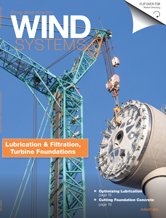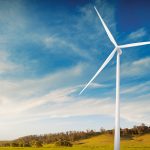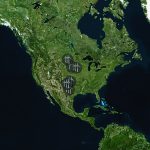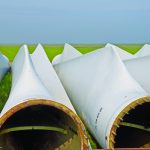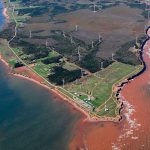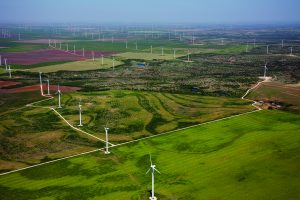The five-year extension of the Production Tax Credit has breathed new life into the wind industry, and as a result, new wind-plant additions are expected to peak at 9 GW in 2018.
The Production Tax Credit and Investment Tax Credit were extended for five years with a gradual ramp-down of benefits for each year.
“The extension rejuvenated the industry,” said Mike Lorusso, managing director and group head of CIT Energy. “Deals that were on the verge of getting done continued along and are now going into construction. Further down the road, it jump-started other deals and gave the industry a nice lifeline.”
The PTC extension is significant, said Bruce Bailey, CEO of AWS Truepower, a renewable energy consultant.
“At last, there is certainty about federal-tax incentives over a reasonably long period of time,” Bailey said. “We are seeing clients reactivate their pipeline of greenfield projects, and there are more banks and investors either getting into the game or upping their level of activity. Generally speaking, I’d have to say that there is much more confidence about wind’s long-term future.”
Financing sources are expected to increase as a result of the extension, said Nicholas Knapp, managing director for CohnReznick Capital Markets Securities, LLC.
“This will allow for a higher volume of projects to be completed in a shorter time frame and under a more competitive cost of capital,” Knapp said.
 Construction Breathing Room
Construction Breathing Room
More good news for wind developers comes from the IRS, which said developers have up to four years to complete construction under the extension, which gives them some breathing room and allows for a less frenetic dive toward completion over the next four years.
“Developers are being exempt from the continuous construction rule,” a rule that said in the past that developers only could get the Production Tax Credit if they refrained from taking breaks on a project, said Bruce Hamilton, energy director for Navigant. “This leads to less of a rush.”
If developers begin a project in 2016, they have until 2020 to complete it. Hamilton said this will help boost the fledgling offshore wind industry, which requires up to two- to three-times longer to complete a project.
In the past, developers had to complete projects in two years.
“The five-year extension of the PTC and the four-year IRS guidance certainly have a very positive impact — not only for opportunities next year, but opportunities for the future,” said Jacob Andersen, CEO for Onshore Americas, Siemens Wind Power and Renewables Division. “Now we can engage in long-term planning and continue our investments in new technology to get cost down.”
Siemens now has an opportunity to help customers significantly boost onshore wind power capacity in the U.S. over the next several years.
“We expect that the coming years will be strong for onshore wind installations in the U.S., and we also see positive signs in respect to offshore wind development,” Andersen said. “There is, however, still work to be done on the regulatory environment for offshore wind where we need to find a solution to shorten the currently too long permitting time for development.”
As a result of the PTC expansion, the wind industry should experience high levels of market penetration in 2018.
In 2018, the wind industry’s share of the total market is expected to be about 70 percent of added capacity, but will drop down to about 20 percent in 2021.
Manufacturing and Jobs Increase
Increases in the number of wind turbines online have boosted manufacturing and wind-related jobs. At the end of 2015, there were more than 500 wind-related manufacturing facilities across 43 states, producing products that included major components such as blades, nacelles, and towers, all the way down to smaller components such as bearings, fasteners, and sensors, according to the DOE.
The wind sector now employs more than 70,000 workers and is expected to increase those numbers by an additional 10,000 this year.
Corporations seeking to embrace sustainability are becoming a larger segment of the market. About 37 percent of the MW contracted through power-purchase agreements during the first quarter of 2016 were from corporations and other “emerging” customers, including the Department of Defense, according to the American Wind Energy Association.
Along with a strong short-term outlook comes expected growth in O&M. However, with many new players vying for the business, the O&M market has become fragmented, said Stephen Curtis, director of renewable energy sales for SKF USA.
“A lot more of these independent service providers are getting into the market and doing repairs that involve our products — generators and gearboxes, for example,” Curtis said. “That market tends to be fragmented. There are a lot of players, and the size of the market isn’t clear.”
The size of the market is a moving target, he added.
Hamilton said the major challenges to ensuring the competitiveness of the industry are competition from solar power and reduced demand.
“The price of wind is going down significantly, but solar is going down more significantly,” Hamilton said.
Other obstacles include finding good wind-power sites, given that many of the best sites are taken, and less demand from utilities that have met their Renewable Portfolio Standard requirements, according to Lorusso.
As a result, the major manufacturing gains are taking place internationally, Lorusso said.
In spite of such obstacles, this year got off to a great start. The first quarter of 2016 was the best first quarter since 2012, with 520 MW of wind power added, according to AWEA.
Nearly 9.4 GW in Construction in 2015
About 9.4 GW were in construction as of year-end 2015, according to Navigant. About 8.6 GW were installed in 2015.
“A total of more than 15,200 MW of wind capacity were reported as under construction or in advanced stages of development during the first quarter of 2016 with over 3,500 MW of total new announcements,” according to AWEA’s first-quarter 2016 market report.
Project developers reported more than 10,100 MW of construction activity across 81 projects in 25 states, including more than 2,000 MW of new construction announcements. Texas was home to the majority of construction activity, with nearly 5,500 MW reported. AWEA said that about 5,100 MW of projects were in advanced stages of development.
Navigant predicts 8.2 GW will be installed in 2016, and 7.2 GW will be installed in 2017 in the U.S. And Texas is expected to lead installations.
GE Renewable Energy led the wind-turbine manufacturing sector in 2015, capturing 40 percent of the cumulative market share of installed turbines. Vestas captured 33 percent, and Siemens captured 14 percent, according to DOE.
The U.S. market is expected to continue to grow through 2018 due to PTC incentives, and wind is expected to provide about 50 percent of U.S. generation additions, ranging from 25 percent to 70 percent during that time. Interestingly, 65 percent of the MW under construction is in states with no RPS, Navigant said.
Meanwhile, offshore wind projects are increasing. More than 20 U.S. offshore wind projects are in development, with a combined capacity of about 16 GW. Seven of those projects, or about 700 MW, are in advanced stages of development or construction, according to Navigant.
O&M Growth and Advances
With the growth associated with the PTC extension in both onshore and offshore wind projects comes a robust O&M market and demand for new O&M services — specifically, systems that monitor the status of equipment in real-time and predict wind-turbine problems.
“A recent survey of ours revealed that 86 percent of respondents fully believe service revenue to eclipse product revenue in the next two years,” said Athani Krishnaprasad, co-founder of ServiceMax. “That means companies won’t be making the bulk of their revenue on selling their ‘thing,’ but rather servicing it.”
EDF Renewable Energy, which has more than 10.7 GW of O&M under contract, has seen a 400-percent growth rate since 2007. By the end of 2015, the company’s growth had doubled, said Dalen Copeland, vice president of business development for EDF Renewable Energy.
“We are looking around to try to figure out how to provide the highest value services to customers,” she said.
The company wants to provide a renewable assets intelligence platform that provides real-time transparency on asset performance and allows the company to help improve the performance of plants by zeroing in on what’s causing downtime.
“The wind industry is wrestling with big data,” Copeland said. “Wind plants throw off a lot of data. Depending on what data systems you have installed, you need to make sure you’re getting good data quality and can turn it into something useful.”
Along with the interest in using big data comes a need for research and development in establishing common standards that would allow industry members to share information about wind-turbine “health monitoring” efforts, said Patrick Lemieux, a professor of mechanical engineering at California Polytechnic State University.
“Right now, the big utility machine manufacturers, about 10 worldwide, will each develop their system for themselves in a priority manner,” Lemieux said. “You can’t call GE and have them offer you their turbine-health-monitoring machine. This is their own intellectual property, and they are guarding the science behind it.”
Lemieux said his R&D focuses on helping provide an “open literature-based environment” for such systems so the research is available to the entire industry. This would help improve the competiveness of the industry.
R & D Continues to Focus on Bigger Wind Turbines
The focus of R&D efforts continues to be larger towers and longer blades expected to harness stronger and more consistent winds. This is expected to provide for wind energy harvested in an additional 700,000 square miles, or about one-fifth of the land area in the U.S., according to the DOE.
These R&D efforts also are expected to boost manufacturing close to wind-power sites in an effort to keep transportation costs low. Advanced manufacturing techniques for taller towers — modular assembly or on-site tower production — is seen as a new opportunity for the industry and its suppliers.
In addition, the DOE is funding an effort that will apply 3-D printing to the manufacturing of wind-turbine blade molds. The project aims to improve wind-facility efficiency and cut wind-turbine manufacturing costs.
Simplifying how turbine-blade molds are made is the initial focus. Right now, a ‘plug’ is made and it’s used to make a mold that’s later used to make fiberglass blades. 3-D printing applied directly to the mold process can eliminate the plug, reducing costs and the manufacturing time, according to the DOE website.
In addition, the DOE is working on the Atmosphere to Electrons Initiative, which aims to coordinate and optimize advances in wind-plant aerodynamics, plant performance, financial risk assessment, atmospheric science, and next-generation wind-plant technology.
“The exciting stuff is getting to bigger turbines, and that’s been a continuing march,” said George Favaloro, managing director in PwC’s Sustainable Business Solutions practice. “The Southeast U.S. hasn’t seen much wind development because wind at the ground levels doesn’t have the speed. But if you get up higher, in the 170-meter range, there’s more airflow, so it changes the game.”
While the push for bigger turbines has huge potential, it introduces other problems, he said. Transporting the blades can be difficult.
Like the DOE, Favaloro said he expects to see more components made on-site.
Overall, the industry is thrilled with the extension of the PTC and ITC and the opportunities the extension affords.“Wind financiers have been dreaming about a long-term PTC extension for nearly two decades,” Knapp said. “A long-term view allows the existing tax equity investors and lenders to develop multi-year allocation of capital for budgeting purposes. It allows new tax-equity sources that were otherwise on the fence due to unreliable PTC policy to now take action and secure final approval to officially enter the market.”
Website: www.RealEnergyWriters.com
















